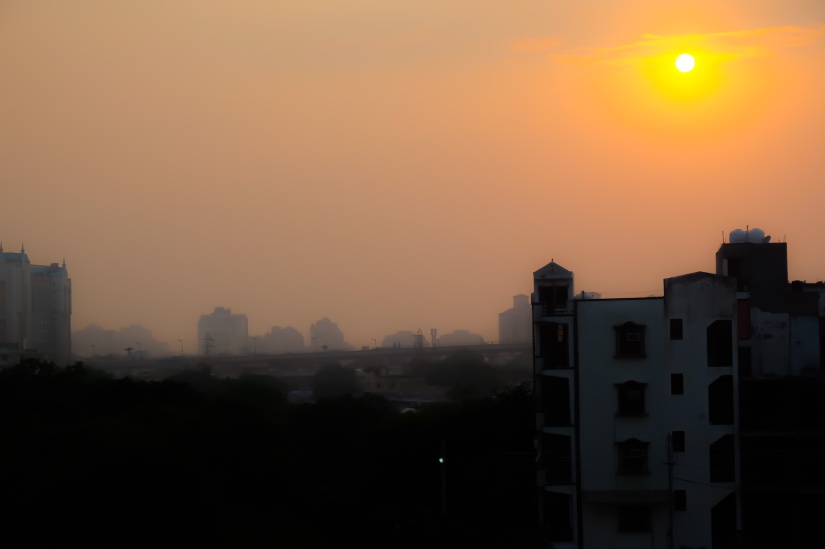
A chipmunk skitters across my path, his striped grey and white body a blur against the ochre coloured ground. He reaches his destination and bounds up the bark up of a tiare tree, one of many crowding the edges of the path. The creamy white petals of the tiare flowers look as if as they have been dipped in honey at the centre.
Underneath my own sandals, thick brown mud squelches out. Overnight, lashing, swollen raindrops have transformed the entire road from dusty track to river of mud. Lake like puddles of water fill the track. The difference is that here, there’s no toddlers splashing around in rubber boots. People gingerly step on thoughtfully placed stones or follow flattened car tracks to avoid muddying the hems of their rainbow-coloured clothing.
Hefting his wagon, one fruit seller marches boldly through the water, confident in rubber flip flops and clearly accustomed to not letting a monsoon downpour slow his day. The daily commute of Nathapur, a small village on the outskirts of Gurgaon, India continues despite the flooding.
Blaring horns, each engineered to create its own ear-splitting sound announce the presence of school buses, motorbikes and taxis. Careering along on three small tyres, auto-rickshaw drivers confidently navigate the puddles of water, leaving a triangular wake behind them. They look like small green and yellow ships in a sea of brown.
To my uninformed eyes, the churning muddy paths spell out rainy season. A teacher at the local school tells me however, that this is a worryingly dry monsoon season. Nowhere near the expected number of deluges have fallen around New Delhi. Meanwhile, one month’s worth of rainfall hit Mumbai in 24 hours and in Tamil Nadu, Southern India, water is being rationed due to a drought. The polarity between over-abundance and scarcity of water is frightening.
Early mornings here frequently start with no water coming out the tap. Other days, we walk past labourers showering vigorously beneath streams of water before their day begins. These construction workers live in shacks, erected on-site – their homes until the one year project is finished. And if the Monsoon delays their progress, work continues all through the night in order to meet their deadline.
Huge clouds of dust fly up from forklift trucks dumping great heaps of gravel and men hoist impossibly heavy sacks overhead. Despite the beaten metal trays of bricks balancing atop their heads, the sari-draped women are as upright as candle sticks, bafflingly graceful during the back-breaking work. While Mum and Dad work, the kids play in the rubble and dogs laze atop the pyramids of excavated earth.
They are building a school, a massive affair of dark red brick and square glass windows. The rate at which progress happens is remarkable. Already, the building’s shell looks finished and a driveway has been completed. But then, I remind myself, this entire area of Gurgaon is named after the construction company: DLF ‘phase III.’ The sector’s namesake rises up behind the village, a huge glass skyscraper emblazoned with the company logo, should we forget. Buildings pop up here at lightning speed and in parts of the sector, there’s thriving street-food stands, restaurants and polished apartment blocks. Undergoing such rapid expansion, Gurgaon is fast becoming a go-to suburban spot just thirty minutes by metro to the Delhi metropolis.
From the balcony of my own room in DLF Phase III, the waving leaves of the trees below are a daily reminder that I’m in the tropics, despite the clouded grey sky. Finger-like arrangements of leaves show off their jungly manicure; lime green tips to their large, waxy leaves. Even in the middle of the urban sprawl, plant life blooms determinedly and colourful, feathery birds zip from tree to tree. Hawks circle over the mounds of rubbish in search of breakfast, their majestic wingspan incongruous with the dumping-ground below.
‘Aoo-rruuuh.’ The neighbourhood dogs have taken up their en-masse howling. The cause of all this hullabaloo? A troop of baboons have stepped into their territory. It’s easy to mistake these creatures for dogs, roaming around the edges of the temporary housing. Clutching sweet limes in their uncannily human hands, the monkeys bite into the green skin and spit out the rind, snacking on the pale flesh beneath. Chattering loudly (they are much too agile for the earth-bound canines) the baboons scurry up the walls of the opposite apartment, flying like trapeze artists from one window ledge to the next.
One monkey plays fireman Sam, sliding down a drainpipe and another monkey has a baby onboard. The little creature clutches onto his mother’s back as she climbs the building, his small pink ears flat against a little round head.
Silhouetted against the sky, the baboon family scamper off on all fours in orderly single file in search of a new playground, leaving the baffled dogs barking at a now-empty wall.




Damn good writing, felt like I was there!
LikeLike
Thanks Lewis!
LikeLike